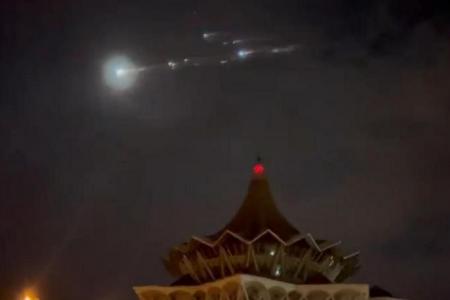Debris of Chinese Long March rocket spotted in Sarawak skies
PETALING JAYA (THE STAR/ASIA NEWS NETWORK) - A huge piece of space junk - apparently from a Chinese Long March rocket has crashed down to earth - with its fiery re-entry spotted by many in Sarawak.
The 22.5 tonne core stage of the Long March 5B rocket re-entered Earth's atmosphere over the Indian Ocean at approximately 12.45 am on Sunday (July 31), according to the US National Aeronautics and Space Administration (Nasa).
The dramatic event was spotted by many people in Sarawak, Malaysia, with videos being uploaded to social media by users from Sibu, Bintulu, Kuching and other places.
Many did not realise what they were witnessing, with some even labelling it a "meteorite".
"Meteor spotted in kuching! #jalanbako 31/7/2022," said Nazri Sulaiman (@nazriacai) on Twitter, although he later corrected himself to say that it was the remains of the Long March rocket.
"Kuching Sarawak.. meteor or apa?" tweeted hanifDaslepzz (@hanifDaslepzz).
Hanif also stated later that it was the Long March rocket and said that an "explosion" was heard over Kuching.
"There is a long streak of clouds ... the people of Kuching have reported hearing the explosion an hour ago," he tweeted.
According to astrophysicist and satellite tracker Jonathan McDowell from the Harvard-Smithsonian Center for Astrophysics: "The video from Kuching implies it was high in the atmosphere at that time - any debris would land hundreds of km further along track, near Sibu, Bintulu or even Brunei.
"It's 'unlikely but not impossible' that one or more chunks hit a population centre," he said in a series of tweets.
The Malaysian Space Agency (Mysa) had previously said that the debris from the rocket was unlikely to land in Malaysia.
"Due to the strong atmospheric drag to the orbit, the debris is expected to enter the earth's atmosphere a few days after the launch.
"Basically, the location of the re-entry of the debris can't be predicted accurately until a few hours prior to re-entry and in many cases, there will be a vast difference in the forecast due to the change in the physical characteristics of the object during re-entry, including location and speed," it said in a statement on Friday, adding that most of the debris would be burnt during re-entry into the earth's atmosphere, with only smaller fragments landing on earth.
"As such, the public need not be concerned about the dangers..."
The Long March 5B blasted off July 24 to deliver a laboratory module to the new Chinese space station under construction in orbit, marking the third flight of China's most powerful rocket since its maiden launch in 2020.
Get The New Paper on your phone with the free TNP app. Download from the Apple App Store or Google Play Store now

